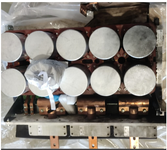FEZAR
Newbie level 6
Hi everyone!
We had trouble with back-to-back converter that install on our wind turbine. Sometimes the converter burned down. The parts that usually were broken were IGBT modules one or two. We use FUJI and INFI converters inside our wind turbine. Unfortunately we don't have any idea about the trouble. We checked stuff like temperature condition, current by phases. We don't have opportunity to check the waveform of Vge, IC,VCE, controller output PWM. because we don't have digital tools for this. Could you please share your thoughts about this problem. Maybe you can give us advice about digital tools and diagnostic procedure. Thank you in advance.
We had trouble with back-to-back converter that install on our wind turbine. Sometimes the converter burned down. The parts that usually were broken were IGBT modules one or two. We use FUJI and INFI converters inside our wind turbine. Unfortunately we don't have any idea about the trouble. We checked stuff like temperature condition, current by phases. We don't have opportunity to check the waveform of Vge, IC,VCE, controller output PWM. because we don't have digital tools for this. Could you please share your thoughts about this problem. Maybe you can give us advice about digital tools and diagnostic procedure. Thank you in advance.
